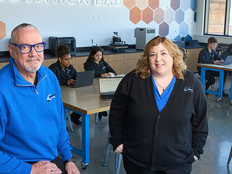Why 21st Century
Four reasons schools should reinvent their classrooms this year.
Educators can easily find statistics that support the adoption of technology in the classroom. Some are obvious: Labor research firm SkillProof claims the number of job openings for IT professionals in the United States increased by 45.2 percent between 2005 and 2008. IBM officials say that by 2010, the codified information base of the world is expected to double every 11 hours. That alone means teachers can no longer teach just the facts, says Dana W. Koch, director of global services for the Virtual High School, a nonprofit organization in Maynard, Mass.
But building a true 21st-century classroom — educational spaces that address media integration, media literacy, and game-based and experiential/simulation-based learning — offers benefits that go far beyond superficial issues.
Here are four long-term reasons the K–12 community needs to begin implementing 21st-century classrooms today:
1. Teaching Effectiveness
The brain is a smart organ. Scientists discovered in the late 1990s that when they continually stimulated rats’ brains with new and novel toys and activity wheels, it triggered a 27 percent increase in their glial cells — the miniature transistors (think liquid crystals) in the brain. On the human side, researchers played an entertaining silent movie at the same time they asked people to listen to a tape-recorded lecture. Turns out, this “distracted” group returned information more easily and displayed more mental flexibility than the control group, which only had to listen to the lecture.
The conclusion: Certain types of stimulation not only change the chemistry of the brain but also can actually increase brain cells and dramatically boost intelligence. And that’s why clinical psychologist Lee Pulos advocates a “super-teaching” approach in classrooms that involves three large screens — in addition to the instructor and computer-controlled projectors — to illustrate the essence of each concept being taught.
Mary Cullinane, director of innovation and business development for Microsoft Education, doesn’t need a sterile lab to confirm these findings. As a former teacher, she knows technology allows educators to present information in more than one way and to change gears quickly when the students don’t understand something. “Before technology, I didn’t have that freedom; it was ‘Here’s how we’re going to look at the lesson, and I hope you get it,’” Cullinane says. “Now we can personalize the content and address it to the auditory learner, the tactile learner, the visual learner.”
Public acceptance of 21st-century skills is overwhelming: 88 percent of those queried say schools should incorporate these skills into curricula, according to a 2007 poll by Public Opinion Strategies.
That’s how visionaries at North County Trade Tech High School in the San Diego area are preparing students for their future. Thanks to interactive whiteboards, notebooks and software tracking systems, this charter high school is an entirely project-based environment, where students spend the day in a personal work space, collaborating with peers to meet the state standards for language arts, science, math and other subjects. According to Kathleen O’Sullivan, director of new schools development for the charter school’s parent company, each student graduates with a diploma and at least one year of an apprenticeship or a year of college credit.
At Minnetonka (Minn.) Public Schools, a new sound system installed in its Pre-K–12 classrooms has helped improve test scores, superintendent Dennis Peterson reports. That’s because every student can now hear the teacher, whether she has her back to the seats or the students are in a far corner working on a project. It’s all about putting students in the center of the education web instead of merely on the receiving end, he adds.
“The explosion of information makes it impossible for the teacher to have all the information at any given time to satisfy students’ natural curiosity,” adds Sonny Magaña, senior education strategist for Promethean, an Atlanta-based manufacturer of interactive learning technology. “This is no longer a top-down decision-making situation. And it’s not a fad, it’s a trend.”
2. Teacher Retention
When IT manager Tony Fernandez unpacked the boxes containing the 200 78-inch Promethean Activboards, 150 AVerMedia AVerVision 300AF+ document cameras and more than 200 NEC VT595 projectors he’d ordered for Academica charter schools in Miami, he anticipated the younger teachers would adopt them quickly. But to his great surprise, the veteran teachers embraced the new technology enthusiastically as well. “It’s changed their perspective on teaching in many ways,” he says. “We were hoping they’d use it, but the level they’ve taken it to is amazing. We’re talking about the whole day for some of them.”
Currently, 50 percent of teachers walk off the job in their first five years, according to Microsoft’s Cullinane. A 21st-century classroom removes much of the time-regulated tension and frustration that was built into a traditional day at school. Consequently, teachers feel more connected, supported and inclined to stick around, she says.
3. Price
When Minnetonka’s Peterson originally asked for technology funds in 2001, the referendum failed. Even the teachers were uncertain why the district needed more money for tools. So the superintendent created a sample classroom of the future containing interactive whiteboards, projectors, a sound system and computers, to serve as his marketing tool. In 2002, the voters overwhelmingly passed the funding referendum, and voted again in 2007 to renew it for another decade.
Today, the price tag to upgrade Peterson’s basic 21st-century classroom package has remained proportional, he reports. “The levy is enough, and we’re moving toward a one-on-one teaching ability through responders and more laptops,” he says. Additionally, educators are looking at ways to incorporate technology like the smart phones and MP3 players students bring from home into the classroom.
Academica’s Fernandez also considers cost a non-issue when it comes to technology. “It is absolutely affordable,” he says. “And because we are a charter school, a school of choice, it is one of the things that attracts students to us.” How affordable is it? Whiteboards break down to pennies per student per day, Magaña’s data shows.
Not to mention, as Cullinane points out, the price of technology can replace what districts pay to provide textbooks annually, so it’s not new money added to the budget.
4. Community Relations
“Today, intellect trumps geography. Would you rather be a smart kid born in India or an average kid born in Seattle?” asks Chip Kimball, superintendent of Lake Washington School District in Redmond, Wash. “Twenty-five years ago the answer was Seattle, because of the advantages in the United States. Now, technology impacts have completely neutralized that equation.
“Districts who build 21st-century classrooms will be creating a community that is more attractive to businesses, job creation, housing and other economic impacts,” he adds. As a blueprint to build an effective 21st-century environment at Lake Washington, Kimball mapped the skills that local businesses need from graduates, and then worked backwards from that profile to build in everything from class schedules to teaching strategies — and the technology.
In San Diego, Trade Tech’s 21st-century classroom model has attracted business, industry and foundation involvement from the local community. Individual business leaders helped decide which curriculum materials to offer, they come into the classrooms to teach, and they serve as evaluators on projects to determine how many credits students should receive for their work. Best of all, O’Sullivan has accepted nearly $2 million in donations for Trade Tech High School from these stakeholders.
“It’s the old Rip Van Winkle story,” she says. “If you fell asleep 100 years ago and woke up today in a classroom in a typical school, it would look the same. Yet when you walk out the door, everything in our world has changed — every sector in public and private industry, every nonprofit has had to make monumental shifts. We need to make sure our students don’t have to check the real world at our door each morning.”
Changing Times, Changing Skills
In 1967, the production of material goods (such as automobiles) and delivery of material services (such as construction) accounted for nearly 54 percent of U.S. economic output. Thirty years later, the development of information products (computers, for example) and the provision of information services (financial and broadcast services) accounted for 63 percent of the country’s output, says a new report from the Partnership for 21st Century Skills. This dramatic shift places a greater emphasis on knowledge and innovation than did the industrial age.
Businesses now require workers who can handle more responsibility and contribute more to productivity and innovation, according to the partnership’s report, 21st Century Skills, Education & Competitiveness. From 1995 to 2005, the United States lost 3 million manufacturing jobs, but created 17 million service-sector jobs. It is critical that the United States keep pace with the changing demand for skills and graduate students capable of filling those jobs, says Partnership President Ken Kay.
History in the Making
While some technologies gaining popularity today once drew cold shoulders from schoolteachers, the history of ignoring innovation in education goes back much further than the interactive whiteboard.
At the turn of the 19th century, one-room schoolhouses shifted to schools with multiple classrooms organized by grade levels, and an exciting technology was introduced: chalkboards. Up to that point, the only slate in the room was the small, handheld variety used by students for peer-to-peer instruction, says David “Dock” Dockterman, an adjunct lecturer at Harvard Graduate School of Education and chief academic officer at Scholastic’s Tom Snyder Productions, a publisher of educational software.
“And guess what? The teachers didn’t use them. The kids knew their way around a chalkboard better than the teachers did,” he laughs. During the next eight decades, classrooms saw a parade of new technologies, from lantern shows to radio to film projectors until computers became the next innovation.
“It’s been wave after wave of looking at what is exciting to people outside schools, and bringing that in. But the actual instruction didn’t change,” says Dockterman. The 21st-century classroom trend, however, shows signs of being a game changer, in his opinion.
“What excites me is that you hear teachers say, ‘I didn’t know I could do that. I didn’t know my kids could do that.’ That’s a real indicator that something fundamental is happening,” he adds.






